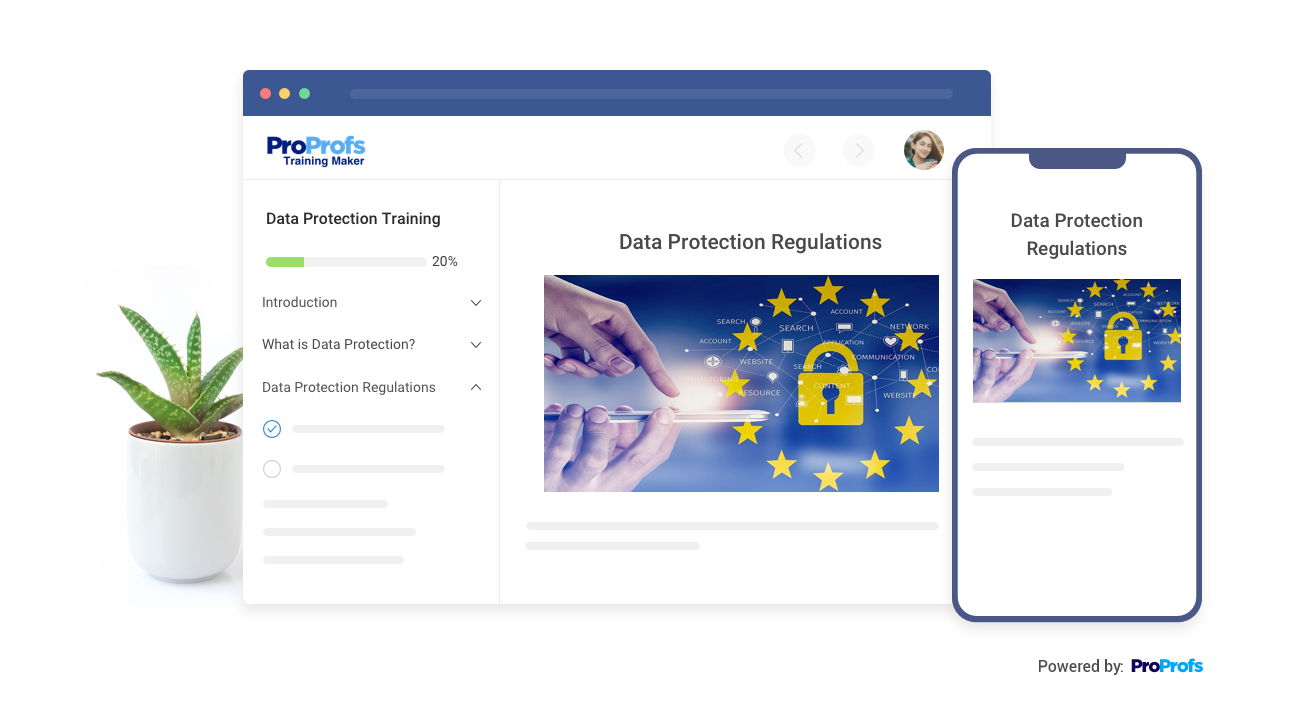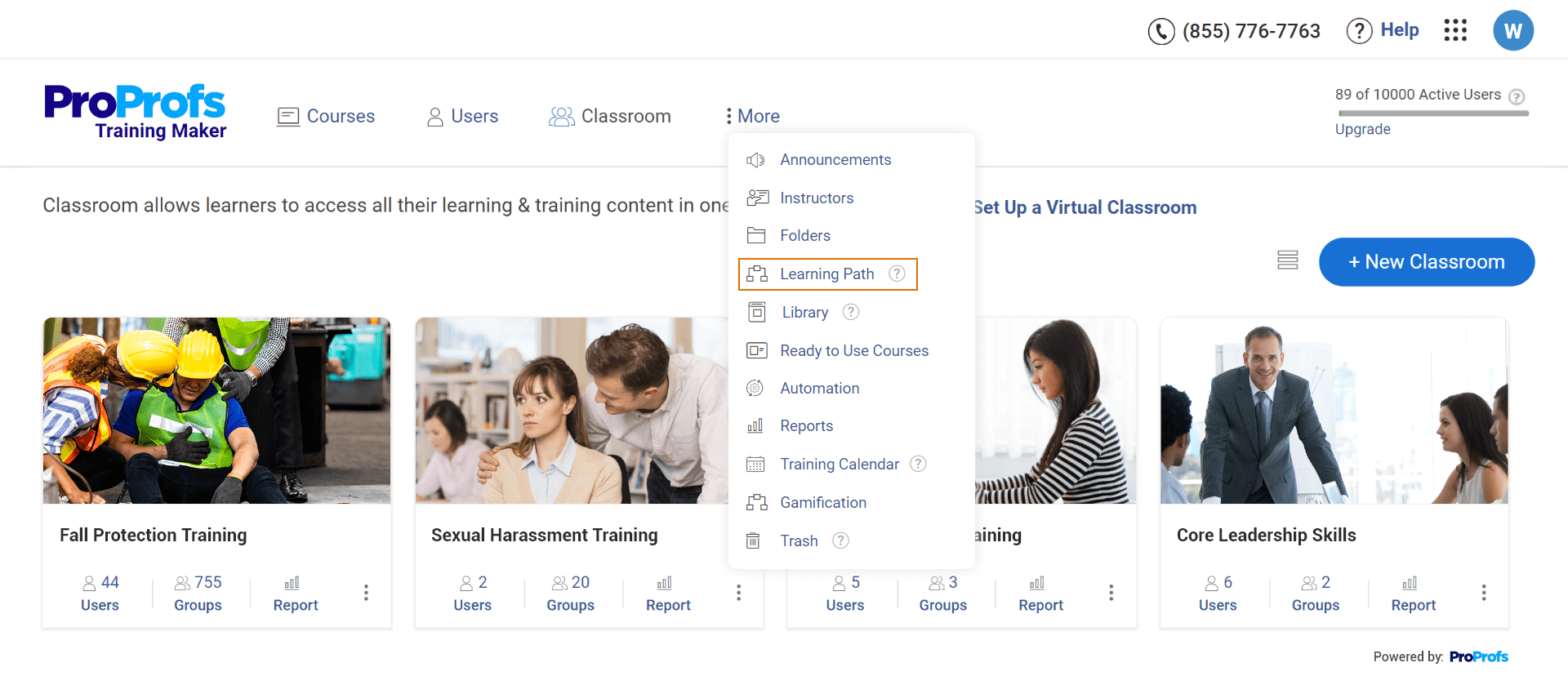After spending several years in the online training space, I’ve realized that security awareness training is one of the essential training programs for employees.
In this blog post, I will share the wisdom I’ve gained from my stint to help you make the most of this training.
Types of Security Training for Employees
There are different types of security awareness training for employees. Some of the most common ones based on the deployment type are:
- Classroom Training
- Online Training
- Video Training
- Simulation Training
1. Classroom Training
In classroom training, security awareness education is imparted to employees in a face-to-face setting, usually led by an instructor or a security expert.
The instructor can use various methods to engage the learners, such as lectures, discussions, quizzes, games, or demonstrations. Sometimes, instructors also deliver training through virtual classrooms.
The benefits of classroom training are that it can cover many topics in one session and foster an interactive learning culture. Plus, it can allow for immediate feedback and clarification from the instructor.
ProProfs Training Maker can help with classroom training to educate employees on security awareness. You can create and administer online classroom training sessions for your employees, regardless of their location and time zone.
Plus, you can easily assign courses, track progress, and generate reports for your learners. Set reminders and deadlines and hand out certificates to ensure compliance and completion.
Here’s a video guide for you to know everything about virtual classrooms.
Watch: How to Set up Reminders and Ensure Course Compliance
2. Online Training
In this type of employee security awareness training, you can deliver security awareness courses to employees through an online platform, usually accessible from any device, at any time, and any location. The platform can offer various modules that contain some slides of content followed by some questions to test the learners’ understanding and retention.
The best part of this training type is that it can be personalized based on the learner’s needs. It is interactive and convenient for the employees, empowers them to take charge of their learning, and reduces the cost and time of training.
A cloud LMS can help in providing a scalable, accessible, secure, and cost-effective platform for delivering online courses.
Watch:What is a Cloud-Based Learning Management System?
3. Video Training

As the name suggests, this process uses videos to demonstrate real-world examples of security threats and how to prevent them.
The videos can be shown to a group of employees in a meeting room or be part of a cloud-based training program that the employees can watch individually.
This training type can be fun, memorable, and effective for employees. It can increase their awareness and confidence in dealing with security risks and leverage the power of storytelling and emotions to influence behavior.
4. Simulation Training

Simulation training immerses employees in realistic, attack-mimicking scenarios designed to replicate actual threats such as phishing, ransomware, and social engineering tactics.
Employees actively identify and respond to device, data, network, and application security risks through these simulated challenges, receiving real-time feedback and expert guidance to hone their skills and decision-making.
This relevant training method measures employee preparedness, significantly boosting their resilience and confidence in handling real-world security incidents.
9 Best Security Awareness Training Programs and Courses
Here are some of the best security awareness training programs and courses, each focusing on different aspects of security.
- Phishing Awareness
- Password Security
- Social Engineering
- Data Protection & Privacy
- Device Security
- Remote Work Security
- Security Policy & Compliance
- IoT Security
- Cloud Security
1. Phishing Awareness
This training teaches you how to identify ghost jobs, fake emails, texts, and websites that try to steal your information. Learn to spot red flags like suspicious links, bad grammar, and urgent requests.
2. Password Security
Master the art of creating strong, unique passwords for all your accounts. Discover tips for remembering them securely and avoiding common mistakes like using birthdays or weak phrases.
3. Social Engineering

Learn how to recognize manipulation tactics like pretending to be someone you trust to gain your information. Develop strategies to say no confidently and avoid falling for these scams.
4. Data Protection & Privacy

Understand the rules of the game for protecting your data. Learn about privacy laws, how your company handles your information, and your role in keeping it safe.
5. Device Security
Build a security shield around your devices, including mobile phones, laptops, and even smart appliances, with this security awareness training course. Discover how to configure security settings, use Wi-Fi safely, and avoid malware that can steal your data.
6. Remote Work Security
Set up your home office for maximum security. Learn to secure your network, handle sensitive information responsibly, and communicate effectively about any suspicious activity.
7. Security Policy & Compliance
Speak the language of security within your company! Understand your organization’s security policies and procedures to ensure everyone plays by the rules and protects valuable data.
8. IoT Security

Keep your smart home safe from unwanted guests. Learn about vulnerabilities in connected devices, how to choose secure ones, and what to do if something seems fishy with your speaker or doorbell.
9. Cloud Security
Turn the cloud into a secure vault for your files. Discover how to choose reliable cloud providers, encrypt your data for extra protection, and control who can access it.
5 Steps to Create & Implement Security Awareness Training
Building strong security awareness training online is crucial in today’s digital landscape. It empowers your employees to become your first line of defense against security threats.
Here’s a step-by-step guide to help you create and implement a program that fosters a culture of security:
Step 1: Secure Buy-In

This step is all about gaining support from leadership and setting clear goals for your security awareness program. Imagine it as building a strong foundation for your security castle.
- Executive Sponsorship: Gain leadership support by highlighting the cost of security threats and the benefits of a secure workforce.
- Stakeholder Engagement: Involve IT, HR, and department heads in planning and communication.
Step 2. Assess Your Training Needs
Next, you need to assess the training needs of your employees. This step focuses on assessing employees’ security knowledge, gaps, and vulnerabilities to tailor training effectively.
- Gap Analysis: Identify your organization’s specific security risks and employee knowledge gaps through assessments and interviews. Here’s a detailed guide on How to Conduct an Effective Skills Gap Analysis.
- Target Audience: Tailor training content and delivery methods to different roles and technical levels.
Step 3. Design Engaging Training
Once you’ve assessed the training needs, the next step is to create training content using real-world scenarios, varied formats, and interactive elements.
With an LMS like ProProfs Training Maker, you can create engaging courses in just a few minutes. You can use the readymade templates or simply create your content using your existing docs, PPTs, podcasts, images, and videos.
- Microlearning: Break down content into bite-sized, digestible modules for better retention.

- Interactive Formats: Use text, images, videos, docs, simulations, gamification, and quizzes to keep learners engaged.
- Real-Life Scenarios: Use relatable examples and case studies to illustrate security threats and best practices.
Step 4. Implement and Deliver
This step is about implementing and measuring the effectiveness of your training program. It’s like putting your knights through drills and testing their skills against mock attacks.
- Variety of Channels: Offer training through online modules, workshops, webinars, and in-person sessions for accessibility. Blended learning would be an ideal option.
- Regular Schedule: Conduct training regularly throughout the year, not just once a year.
- Communication Strategy: Keep employees informed about the program, its goals, and its benefits.
Step 5. Measure and Improve
Ensure your security awareness training program isn’t a set-and-forget item. You should track its effectiveness through data analysis and feedback. Based on insights, you can refine the content, delivery methods, and communication strategies to strengthen your organization’s security measures continuously.
- Track Completion Rates: Monitor participation and completion of training modules.
- Conduct Phishing Simulations: Assess the effectiveness of training through simulated attacks and measure improvement over time.
- Gather Employee Feedback: Use surveys and feedback sessions to understand employee engagement and identify areas for improvement.
Watch: How to Create a Survey Using ProProfs Survey Maker
Bonus Tips
- Make it fun! Infuse humor and storytelling to make learning more enjoyable and memorable.
- Lead by example. Executives and managers actively participating in training should set a positive tone.
- Create a culture of openness. Encourage employees to report suspicious activities and ask questions without fear.
- Continuously update. Stay up-to-date on evolving threats and adjust your program accordingly.
By following these steps and adapting them to your organization’s unique needs, you can create a successful security awareness training program that empowers your employees and builds a strong security culture.
How to Measure the Effectiveness of Your Security Awareness Training
For years, I’ve seen employee security awareness training as a crucial line of defense for protecting our organization from security threats.
But simply checking a “training completed” box wasn’t enough. My organization needed to know if it was sticking and if our employees were truly equipped to recognize and respond to these attacks.
This is why I saw a multi-pronged approach to measuring our program’s impact.
My company conducts surveys before and after training. This gives it valuable insights into employee satisfaction, engagement, and knowledge retention. It also allows it to gauge their pre-existing attitudes and beliefs towards security and how the training might have shifted them.
Second, the company regularly runs simulated phishing tests. These realistic scenarios put our employees to the test, revealing their actual behavior when faced with a security attack. This data is invaluable in identifying areas where we can strengthen our training content and equip learners with the skills to handle real threats.
Last but not least, my company tries to closely monitor event logs and security metrics. By tracking the number and severity of security incidents related to human factors, it can quantify the training’s impact on our overall security posture.
By combining these methods, the company gains a holistic understanding of how our security awareness training is performing. I am optimistic that these strategies will also work for you.
So go forth, implement these approaches, and witness the positive ripple effect of a well-informed and engaged workforce!
Get Free Employee Training Software — All Features, Forever.
We've helped 567 companies train 200,000+ employees. Create courses in under a minute with our AI LMS or use 200+ ready-made courses on compliance, harassment, DEI, onboarding, and more!
Invest in Security Awareness Training!
Investing in security awareness training for employees is an investment in your company’s future.
By empowering your employees to be the first line of defense, you build a resilient organization capable of withstanding the ever-evolving security threats.
Remember, security is a team effort – turn your trained employees into your strongest line of defense.
So, take action today!
Frequently Asked Questions
What is security awareness training?
Security awareness training is a program that educates individuals about security risks and best practices. It covers topics like identifying phishing emails, creating strong passwords, and recognizing online threats to enhance users’ ability to protect themselves and their organizations from all kinds of threats.
What is the main purpose of security awareness training?
The main purpose of security awareness training is to reduce the risk of security incidents by educating individuals about potential threats and teaching them how to adopt secure behaviors. It aims to create a vigilant and proactive security culture within an organization.
How effective is security awareness training?
The effectiveness of security awareness training varies, but regular, interactive, and relevant training can significantly improve participants’ ability to recognize and mitigate risks. Ongoing reinforcement and realistic scenarios enhance effectiveness.
How often should security awareness training occur?
Security awareness training should occur regularly, ideally at least annually, to keep individuals informed about evolving threats and reinforce good security practices. However, the frequency may depend on organizational needs and the dynamic nature of threats.
How long does it take to build a security awareness training program?
Building a security awareness training program can take several weeks to months, depending on the complexity, content, and customization required. It involves creating engaging materials, identifying key topics, and aligning content with organizational policies and risks.
How long do security awareness training courses typically last, and is there a recommended duration?
Security awareness training courses typically last from 30 minutes to an hour, with shorter, more frequent sessions being more effective. Regular, bite-sized training helps maintain engagement and knowledge retention. There isn’t a fixed duration, but adaptability to users’ attention spans is crucial.
How much does a security awareness training program cost?
The cost of a security awareness training program varies based on factors like the provider, customization, and the number of users. Costs can range from a few dollars per user to several hundred, depending on features and complexity.
 Tips
Tips
We’d love to hear your tips & suggestions on this article!
Get Free Employee Training Software — All Features, Forever.
We've helped 567 companies train 200,000+ employees. Create courses in under a minute with our AI LMS or use 200+ ready-made courses on compliance, harassment, DEI, onboarding, and more!


 We'd love your feedback!
We'd love your feedback! Thanks for your feedback!
Thanks for your feedback!






